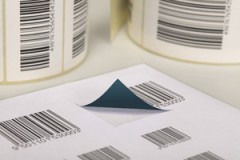Herma - New application of multi-layer technology in adhesives: Opaque labels, safe migration
Until now, label printers and users had to make compromises in cases where nothing must show through the label material: either the choice of suitable coloured label materials was very small, or they had to rely on a material with a coloured adhesive. Due to the soot particles usually contained in the latter, these adhesives have different qualities than conventional types, and are not at all suitable for direct contact with foodstuffs. But such compromises are now history, as shown by HERMA in a world premiere at the Labelexpo 2017 trade fair in Brussels (hall 5, stand C14). Thanks to HERMA’s innovative multi-layer technology, most label materials can be easily turned opaque without affecting the properties of the adhesive, but with a maximum of migration safety. The new HERMAperfectOpaque adhesive range can therefore cover even critical applications demanding, for instance, extremely high tack, or featuring damp and/or cool substrate surfaces. The opacity achieved by means of the multi-layer technology equals that achieved through previous methods.
No new adhesion or processing tests required
“Colouring the adhesive is not a completely new idea”, explains Dr. Ulli Nägele, head of research and development at HERMA. “However, the prevalent use of soot inevitably changed the adhesive properties of conventional, one-layer adhesives. Until now, it was also unthinkable for such coloured adhesives to receive the approval for direct contact with foodstuffs. Employing our multi-layer technology, we colour only the second layer – with a new pigment that is suitable for direct contact with foodstuffs. The adhesive layer immediately affecting the substrate remains unchanged.” Since this layer is exclusively made from proven standard adhesives, HERMAperfectOpaque can be used without requiring time- and labour-intensive adhesion and processing tests. This enables a high degree of versatility, since it allows for label materials and adhesives to be flexibly combined to achieve optimal opacity for various applications. HERMA’s product range thus covers not only films and paper but also thermal Eco adhesive materials – thanks to the multi-layer technology, it is now possible to produce opaque thermal adhesive materials without any compromises regarding adhesion. Moreover, HERMAperfectOpaque makes it possible to produce opaque thermal Eco adhesive materials that do not require a barrier layer (reverse side coating): unlike soot, which was used until now, the new colour pigments do not influence the thermal reaction.
Dark blue colour maintains the whiteness of labels
Initially, the new HERMA range of opaque labelling materials will feature two different adhesives: HERMAperfectOpaque 62Gpo and HERMAperfectOpaque 62Dpo. In addition to providing migration safety, the 62Gpo is suitable for applications requiring extremely high tack despite damp and cool conditions. The 62Dpo adhesive, on the other hand, is ideally suited for the production of opaque copy/laser labels: it prevents bleeding over the die-cut edges during label conversion. Even if they do not have a safety margin, labels produced with this adhesive are sure to be processed smoothly by all copiers and printers.
In both cases, the second layer is coloured with dark blue pigment. “Tests in our development lab have shown that while it is not possible to increase opacity with black pigment, this colour also affects the whiteness of the label material. In our opinion, dark blue is a better choice since it maintains the whiteness”, explains Dr. Nägele. Opaque labelling materials have been in high demand for years. Labels made from such materials are, for instance, used to cover misprints or to localize imported or reimported products. “In view of the wide range of products and packaging materials, label printers gain an important advantage through the extra flexibility provided by our new solution. This applies to label materials that can now be used as well as application safety.”
Photo caption
Multi-layer technology makes it possible to produce opaque versions of most label materials – without affecting the properties of the adhesive and with a maximum of migration safety. This makes it possible to solve even critical tasks with ease.






